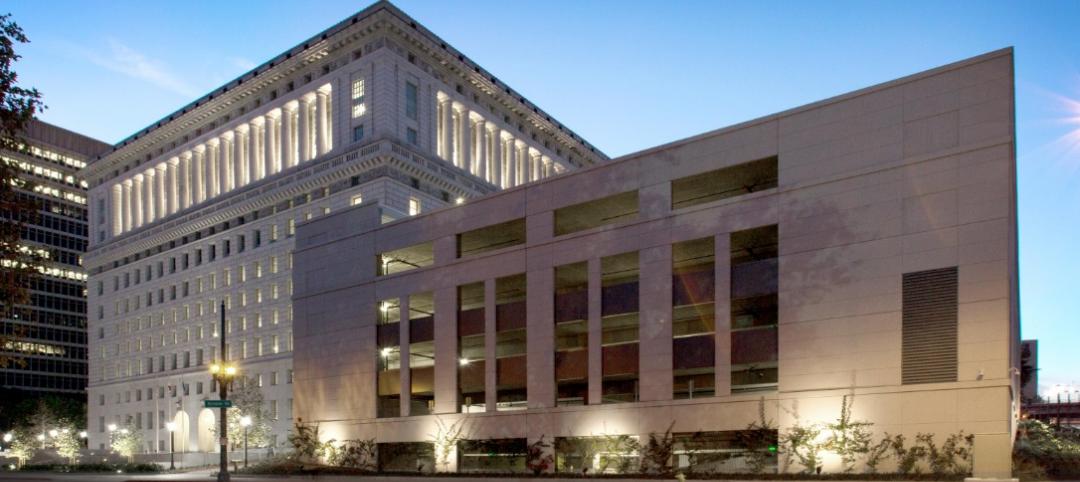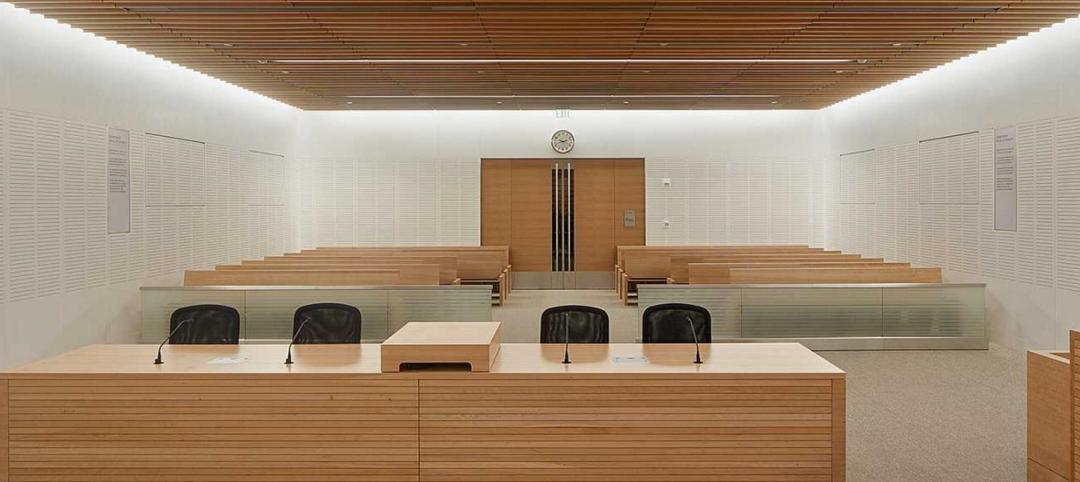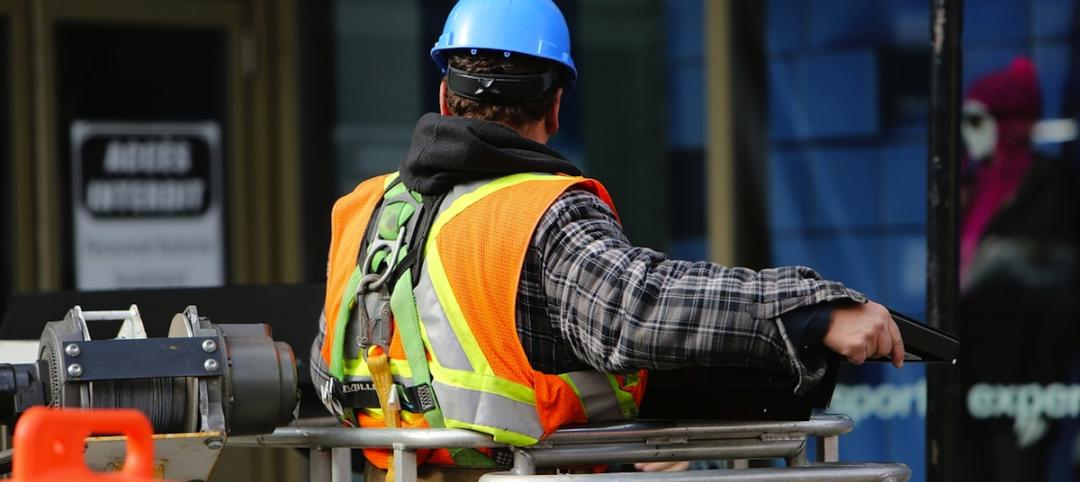
The Robert F. Kennedy Main Justice Building houses the U.S. Attorney General's office, the Justice Department headquarters, and the largest historic art collection of any GSA-built facility, so its renovation had to be performed with the utmost care.
 |
| The building’s art collection required the services of a full-time art conservator and a special “art protection package” for subcontractor bidding. PHOTO: BORIS FELDBLYUM PHOTOGRAPHY |
Offices housing hundreds of lawyers and staff had to remain operational during the construction of a brand new $3.1 million conference center and data room, the restoration of the main library and executive suites, and the installation of a new M/E/P system. All this had to be done while maintaining the highest levels of security and dealing with hazardous materials.
BD+C Reconstruction Awards judge Walker C. Johnson, FAIA, Johnson Lasky Architects, Chicago, assessed the restoration job as “a very difficult project, well executed.”
To best preserve the building's extensive art collection, protective shields were placed around the murals, sculptures, and plaster reliefs. Temperature, humidity, and dust controls were also installed, making the collection much better equipped to stand the test of time.
Due to the highly sensitive nature of the facility itself, extra security measures were employed throughout the project. Construction personnel were classified into three tiers and were permitted access to specific building areas based on these three levels of security clearance.
An extensive asbestos abatement effort was conducted, along with the removal of lead paint and careful handling of mercury vapor lamps containing PCBs. The construction manager, Gilbane Building Company, established a stop-work rule that brought construction to a halt the moment any hazardous material was uncovered.
Conservation efforts throughout the construction process ultimately returned close to $1 million to the GSA's purse.
For instance, instead of completely demolishing the existing courtyard plaza and garage structures, the design consultants determined that it was possible to renovate these features, thereby utilizing 95% of existing building materials. The courtyard's cobblestone blocks were removed, cleaned, refurbished, and reinstalled. The foundation of the courtyard's original fountain was preserved, while its pipes and pumps were replaced. And only the concrete with questionable integrity around the facility's garage beams was removed and repaired, rather than replacing all the concrete.
As for the facility's plaza deck, the Building Team tested the concrete structure's integrity to determine which sections could be repaired instead of being entirely rebuilt. Consequently, 14,520 tons of waste material were diverted from landfill.
The original foundation and structure of the building's entrance was preserved, saving another 110 tons of waste materials and decreasing the risk of penetrating a sensitive waterproofing membrane system.
Gilbane scored additional savings by utilizing a mechanism called early buyout. Taking advantage of the purchasing power of the entire four-phase construction job, Gilbane was able to secure prices early on in the project that otherwise would have been spent covering the escalating costs of building materials.
In sum, the project came in $4.2 million under budget, enabling the GSA to pursue additional work, including restoration and re-pointing of the limestone exterior, roof repair and replacement, ornate painting and plaster restoration, additional hazardous materials abatement, and fire code upgrades.
Related Stories
Giants 400 | Aug 28, 2020
2020 Giants 400 Report: Ranking the nation's largest architecture, engineering, and construction firms
The 2020 Giants 400 Report features more than 130 rankings across 25 building sectors and specialty categories.
| May 24, 2018
Accelerate Live! talk: Security and the built environment: Insights from an embassy designer
In this 15-minute talk at BD+C’s Accelerate Live! conference (May 10, 2018, Chicago), embassy designer Tom Jacobs explores ways that provide the needed protection while keeping intact the representational and inspirational qualities of a design.
Government Buildings | Feb 4, 2016
Bronx police station design revealed by Bjarke Ingels Group
The blocky, modern design is meant to convey accessibility and public service.
| Jan 14, 2016
How to succeed with EIFS: exterior insulation and finish systems
This AIA CES Discovery course discusses the six elements of an EIFS wall assembly; common EIFS failures and how to prevent them; and EIFS and sustainability.
Justice Facilities | Nov 13, 2015
Los Angeles's Hall of Justice gets a reprieve
After being unoccupied for 20 years, the downtown Los Angeles judicial center was revitalized through a restoration effort that proved to be a considerable engineering and construction feat.
Justice Facilities | Nov 10, 2015
AIA: The year's best justice facilities
CO Architects, RMKM Architecture, and SOM are among the firms honored with 2015 Justice Facilities Review Awards from the AIA’s Academy of Architecture for Justice.
Justice Facilities | May 4, 2015
San Diego prison designed with rehabilitation in mind
Following the approach of detention centers in Austria and Norway, KMD and HMC Architects designed a prison rich with natural light and amenities.
Justice Facilities | Mar 5, 2015
New courthouse blossoms into a civic space for one California town
The building's canopy suggests classical courthouse features of front porch and portico. It also helps connect the building with a public plaza that has re-centered civic activity and public gathering for the town.
Justice Facilities | Mar 5, 2015
State of the state: How state governments are funding construction projects
State budget shortfalls are making new construction and renovation projects a tough sell, leading lawmakers to seek alternative funding for these jobs.
Codes and Standards | Mar 5, 2015
Construction problems at prison spur support to quash non-traditional project delivery in Iowa
Iowa lawmakers are investigating construction problems at the Fort Madison prison project and are scrutinizing rules regarding project delivery on state projects.















